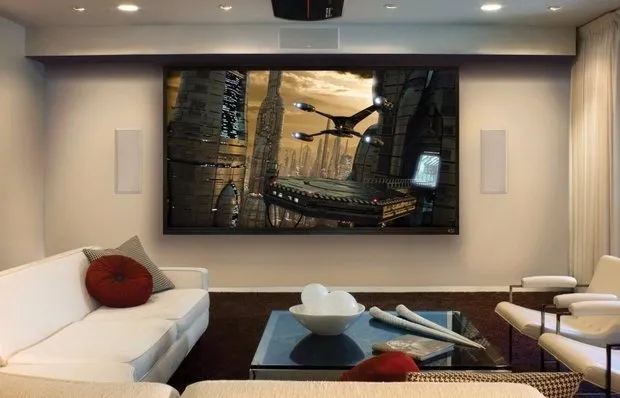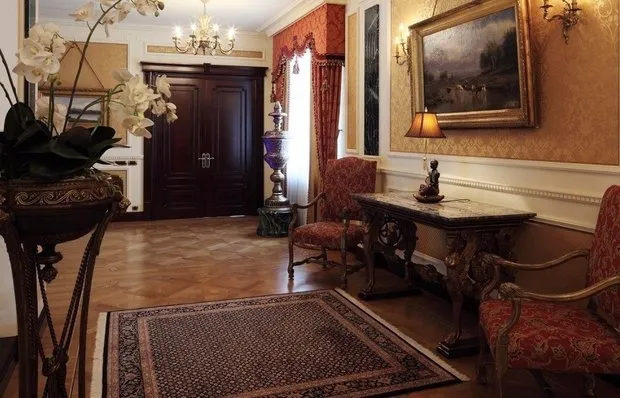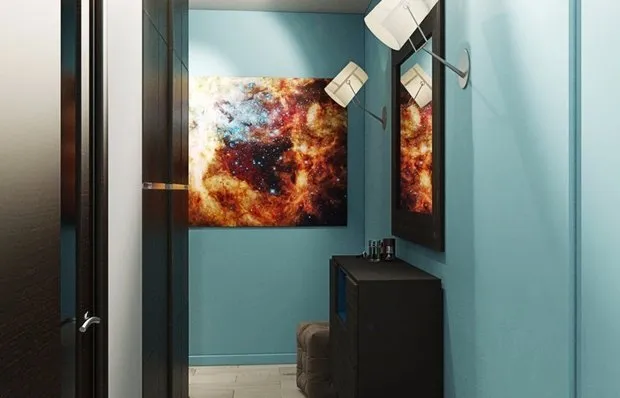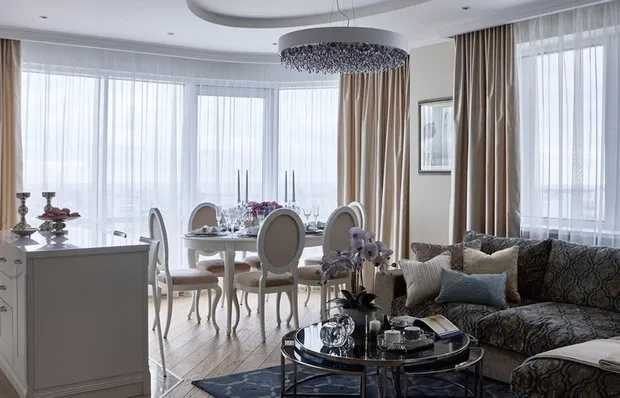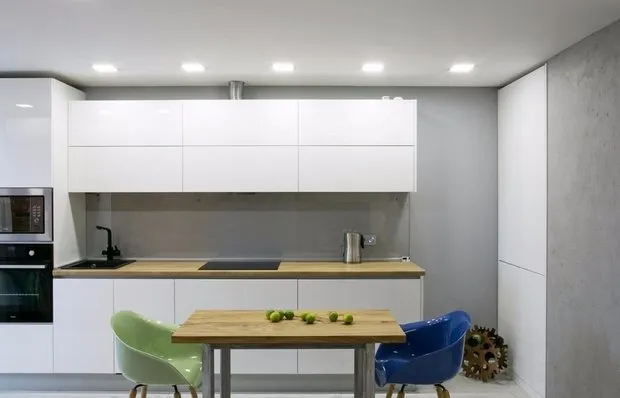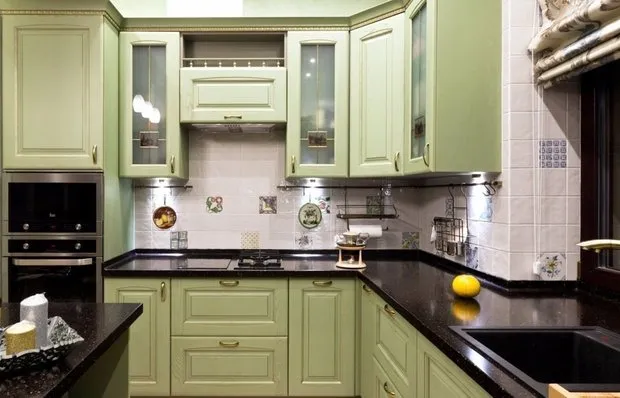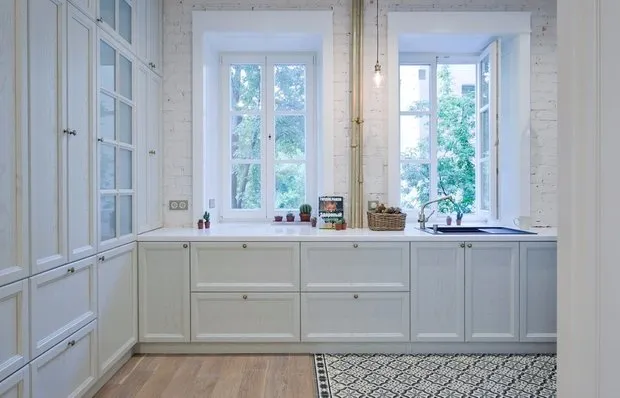There can be your advertisement
300x150
Flooring for Kitchen
Every housewife surely knows what the kitchen floor should be like
Among the main requirements are resistance to moisture, cleaning agents (including aggressive ones), scratches and other mechanical impacts. Manufacturers offer a wide range of materials. What kind of flooring is best for the kitchen? The types and properties will be discussed below.
Kitchen Linoleum
A budget-friendly and quite practical option for kitchen flooring. Modern linoleum is characterized by good sound and heat insulation, high resistance to wear, and a service life of no less than 8 years. This is a very low-maintenance material: regular wiping with a damp cloth is sufficient for long-term use. There are also other advantages:
- ease of installation: you can lay it yourself without hiring professionals;
- a wide range of textures and shades is available in stores: you can always find a covering that most accurately corresponds to the stylistic direction of the kitchen;
- linoleum with a pattern in stores allows you to create interesting compositions from a design perspective.
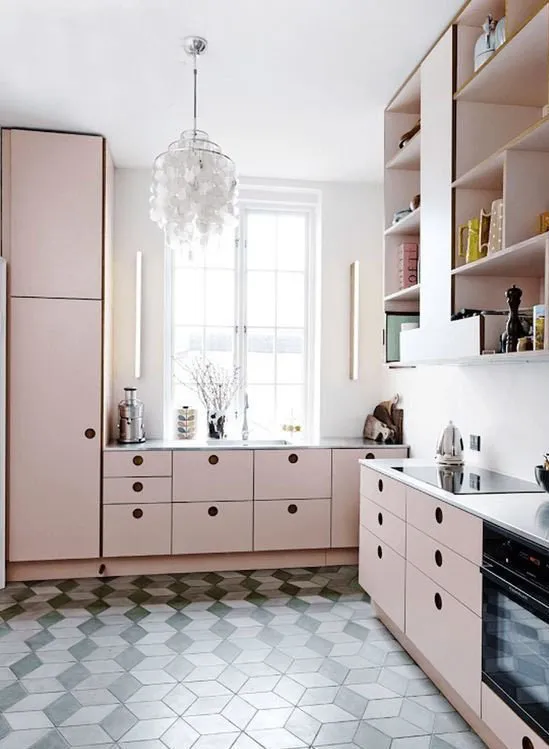
Features of Floor Coverings
When buying this type of floor covering, do not forget that it is far from the cleanest ecological material. Therefore, pay attention to the smell: it should not be sharp. Among the safest types of linoleum, you can mention more expensive molon and artolium. Also, read the label: some varieties of materials are intended for use exclusively in non-residential rooms. And one more point: choose products with a thick protective layer for the kitchen.

Cork Flooring
This is an environmentally friendly covering. The material is made from cork of cork oak, which is harvested from the tree trunk every few years. It is believed that such a covering has special bioenergetic properties that positively affect human health. Besides, there are other advantages. Cork flooring:
- has anti-static properties: dust on the surface hardly accumulates;
- is harmless to asthmatics and allergy sufferers;
- "is not interested" in microorganisms;
- resistant to the action of moisture;
- "indifferent" to fat and other contaminants;
- in case of minor damage, it immediately restores its original shape (air bubbles located between cork particles help with this);
- has a soft springy surface and gives a feeling of warmth: walking on such flooring is simply pleasant.

Features of Choosing Cork Flooring
In stores, two types of cork panels are available: adhesive and with a click system. The latter is not suitable for installation on a kitchen floor. The reason is that the connecting system is made from a substrate – HDF or MDF boards, which are afraid of moisture. Short-term exposure to water does not cause harm, but if neighbors flood or the plumbing bursts, the click system will swell and the covering will bubble. Therefore, it is better to buy adhesive flooring. There is also a nuance here: the base for such cork must be perfectly flat, i.e., you may have to make a concrete screed or prepare the floor in another way. The main disadvantage of cork flooring is its high cost and labor-intensive installation if it is installed with adhesive.
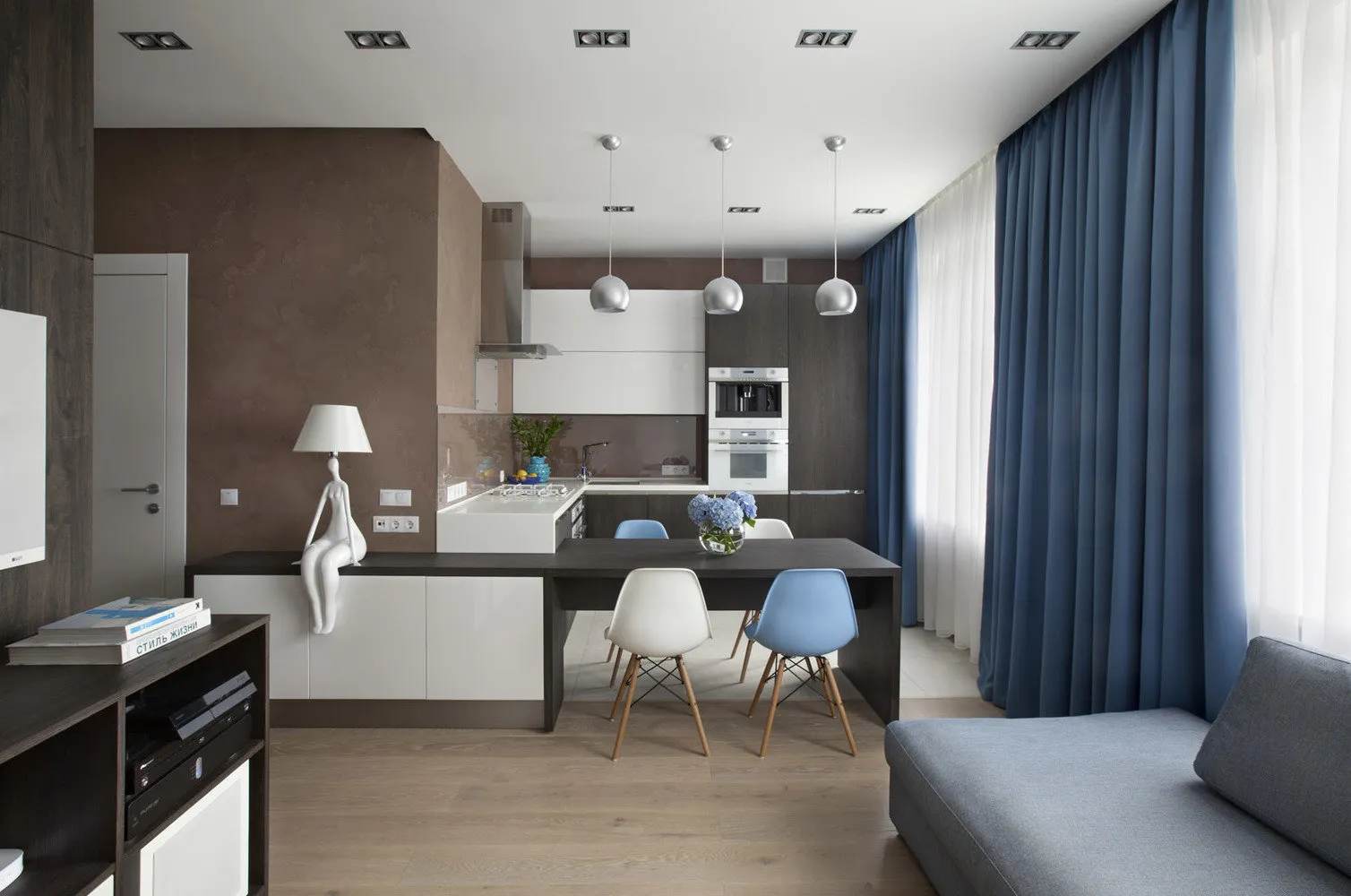
Design: Architect Antonina Sunchugova
Differences in Laminate
It represents an artificial alternative to wooden flooring. Manufacturers produce materials that resemble not only various wood species but also marble, granite, and ceramic tiles. In terms of ecology, laminate is slightly inferior to cork, but this disadvantage is compensated by numerous advantages, including:
- affordable price compared to parquet;
- resistance to mechanical impact;
- a wide variety of textures and shades;
- good thermal and sound insulation (provided that the installation is done correctly);
- possibility of installing a heated floor under the covering;
- simple installation.
The main drawback of such a covering is sensitivity to excessive moisture exposure. Partially eliminate this disadvantage by treating the joints with sealant during installation. In this case, moisture will not seep under the laminate to the base. There is also a feature of installation that requires using special underlayment: without it, the thermal and sound insulation properties of laminate deteriorate sharply. Also, installation must be done on a leveled surface, otherwise, the covering may warp during further use.
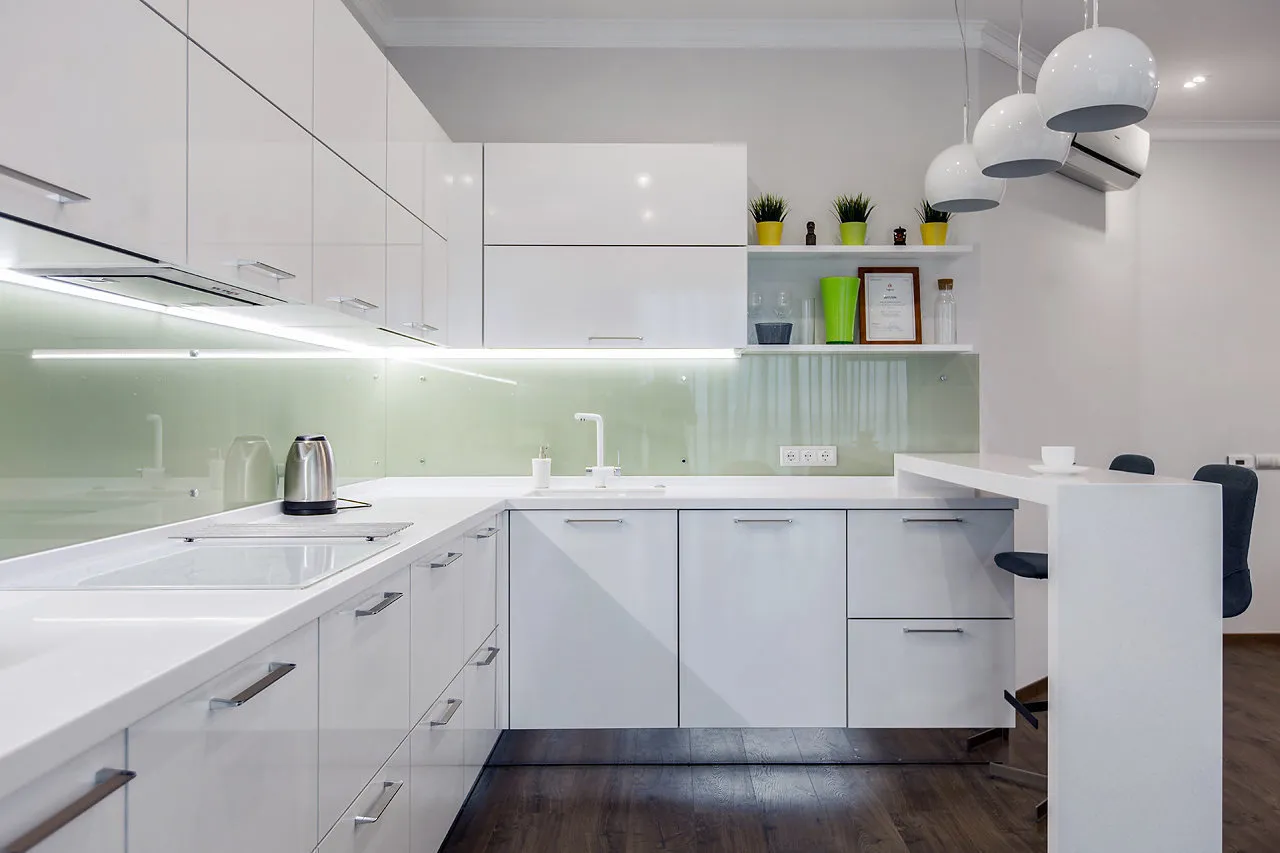
Ceramic Tile and Ceramic Porcelain
These are two types of coverings most commonly used for kitchen flooring. It is worth determining right away how they differ from each other. Their composition is the same, but the manufacturing technologies are different. Unlike regular tiles, ceramic porcelain is fired at a higher temperature and pressure. As a result, its components literally melt and sinter. This allows you to get tiles that have no micro-pores, which are characteristic of ceramic tiles. That is, ceramic porcelain is more resistant to external factors and lasts longer. Both types of floor covering have many advantages:
- resistance to the action of external factors: moisture, aggressive substances, and scratches;
- ease of maintenance;
- long service life;
- ecological safety;
- a wide choice of textures and colors (possible imitation of any natural materials).
Among the negative aspects, one can note poor thermal and sound insulation, as well as the coldness of tiles: walking on them barefoot is unpleasant. This last disadvantage can be eliminated by installing a heated floor system. Also, it should be remembered that ceramic tiles are a rigid material. If glassware falls on them, destruction is inevitable.
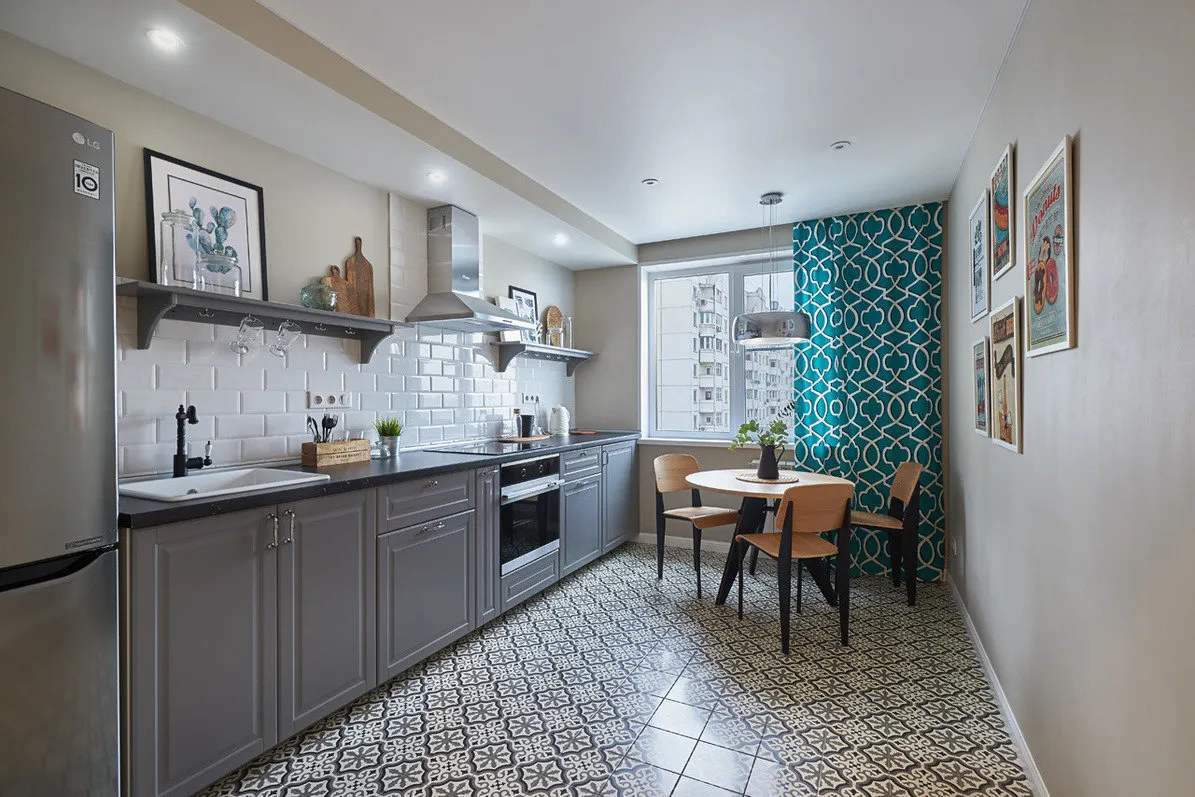
Design: Architect Jeanne Pruvé, Designer Anna Mozharo, Decorator Tatiana Stolyar
Features of Choosing Ceramic Tiles
When buying material, look at the markings: tiles must necessarily be floor tiles with a step pattern, wall tiles are marked by an upturned hand. The second important point is the coefficient of friction (tiles on the kitchen floor should not be slippery). It is preferable that this parameter exceeds 0.75. The next characteristic is wear resistance. For the kitchen, it is recommended to buy tiles of 5th class (GOST) or 3rd class (REI classification). Another parameter is resistance to aggressive substances. If you often use cleaning agents, it is better to buy material marked as "AA". It repels dirt and does not fear household chemicals. Choose matte tiles for the kitchen: scratches and stains on them are not as noticeable. But here too, one should not overdo it: overly rough covering is much harder to maintain.

Design: Dina Salakhova
How Parquet Is Used
It is widely believed that its use in the kitchen is undesirable because it is overly sensitive to moisture, aggressive environment, and temperature fluctuations. However, this is not entirely true: the kitchen is not a bathroom where there are puddles on the floor and steam in the air. If parquet is laid correctly, there is no reason to worry: the covering will last a long time. Considering the high cost of parquet and its installation, most people today prefer parquet boards – a multi-layer material, the upper part of which consists of strips made from valuable wood species. What are the advantages of such a kitchen floor? There are not so many:
- visually resembles natural parquet but costs less and is easier to install;
- comes with a ready-made protective coating (lacquer, wax, or oil), which guarantees protection from grease and moisture;
- installation can be done independently;
- the base material ensures stable and durable (up to 25 years) coverage.
Among the negative aspects, one can note a high price (if compared with laminate or linoleum), the need for special care (special cleaning agents will be required), and the impossibility of patterned laying.

How to Choose Parquet Boards for Kitchen Flooring
The first thing you need to do is correctly select the wood species. The best options are oak, ash, teak, and larch. This type of wood has water-repelling properties, high strength, and resistance to the spread of microorganisms. Also, pay attention to the material structure. If the boards are impregnated with lacquer, they will be glossy. After oil treatment, the material becomes less slippery. One of modern variants is using brushed boards. They are made by destroying the soft upper layer of wood with metal brushes, which makes it look aged. As a result, an unusual texture is obtained, which looks quite stylish.

Design: Oksana Oleynik
Characteristics of Wooden Flooring
Flooring made of planks is an excellent addition to classical interior design. Such a covering harmonizes well with furniture made from solid wood. The material is practical and durable. In addition to this, wooden flooring on the kitchen:
- is ecologically safe;
- poor heat and sound conductor;
- can withstand large mechanical loads;
- installation is not complicated;
- has an affordable price.
However, there are some inconveniences related to installation and use of wooden flooring on the kitchen. Planks do not tolerate constant exposure to moisture and temperature fluctuations. Therefore, it is recommended to use such wood species as oak, ash, larch. These are quite strong and durable types of wood. You can also use less expensive pine or fir, but their service life will be significantly shorter. To avoid deformation of the covering, the planks should be treated with oil or lacquer before installation.

Victorian Flooring for the Kitchen
This refers to a covering in the form of separate plates or square, rectangular tiles with a thickness of up to 3.5 mm. Structurally, they resemble linoleum. As a variation, one can mention quartz vinyl tiles, which differ in higher ecological safety: the material consists of 70% quartz sand. Below are the advantages of this type of floor covering:
- low cost;
- good thermal and sound insulation;
- high resistance to aggressive cleaning agents and moisture;
- resistance to scratches and other mechanical damage;
- anti-slip properties;
- if broken dishes fall on the floor, no damage occurs to the tiles;
- if part of the floor is damaged, it is sufficient to replace the defective tile with a new one without touching the entire covering;
- simple installation.
The disadvantages include sensitivity to various solvents and relatively short service life – 10 years. When buying PVC tiles, pay attention to whether the material has self-adhesive properties – this will significantly simplify the installation process.
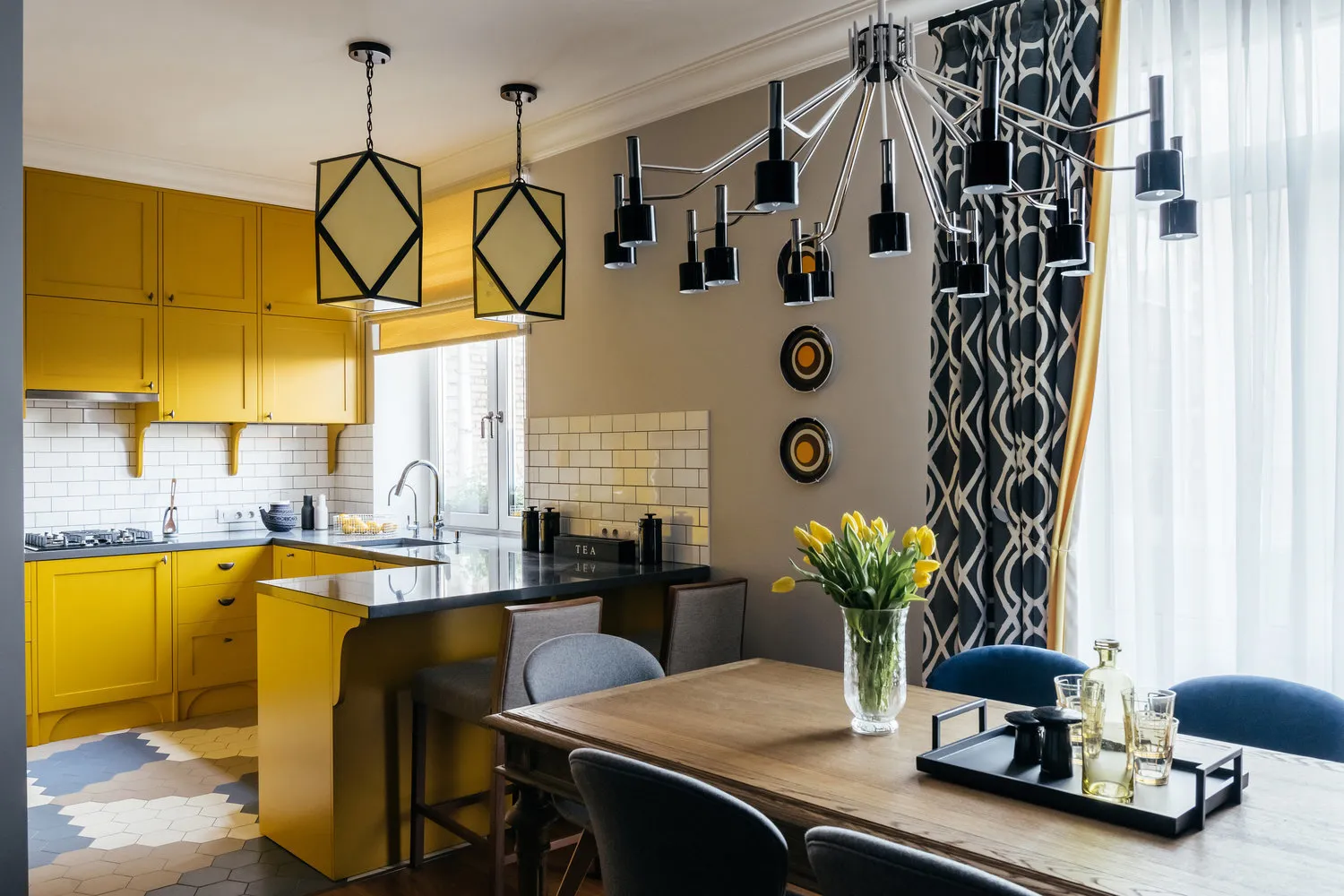
Design: Nadia Zотова's team, design bureau Enjoy Home
Combined Flooring for the Kitchen
This is one of the interesting options for laying flooring in the kitchen. Most often, different types of materials are laid in the working and dining zones. They are combined:
- ceramic porcelain and linoleum: despite the low cost of the latter, the material has a wide selection in terms of colors, which allows you to implement original design ideas;
- ceramic tiles (working zone) and parquet boards (dining area): this option is particularly good in a studio apartment where the living room is combined with the kitchen – different floor coverings form a visual boundary between zones;
- linoleum (working zone) and laminate: if a dish accidentally falls from the cutting board, it will not break.

Color Palette of Floor Covering
When choosing a shade for the floor covering, first consider the overall room color, finishing materials, and furniture: everything should be in harmony with each other. What are the features of the color of kitchen flooring?
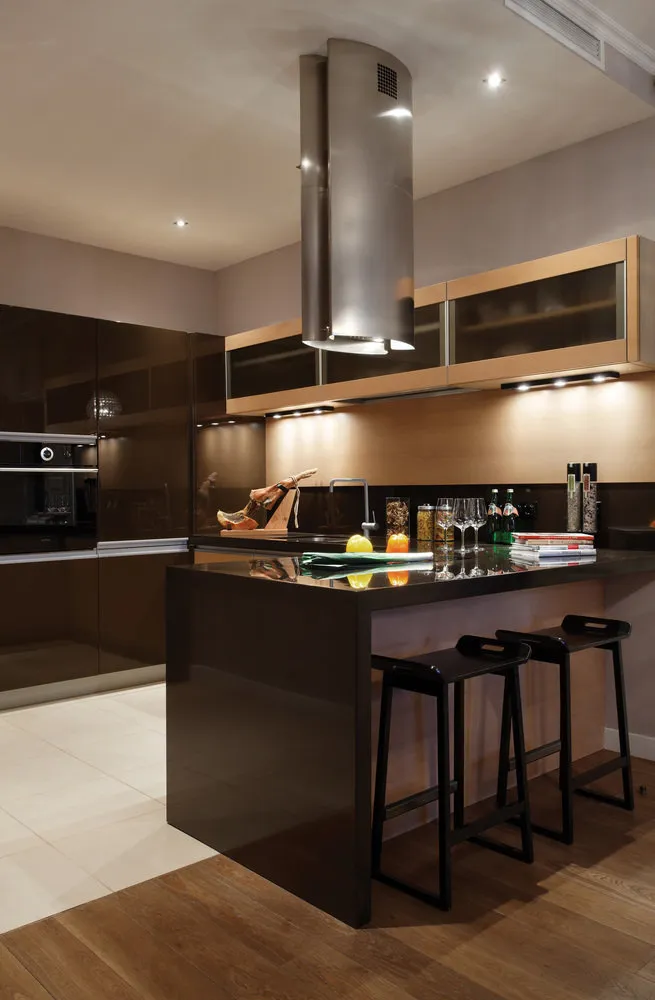
Design: Olga Chernenko
Light and White Tones in Design
Using light tones is especially appropriate for small areas, as it visually expands them. Such a color (milk, gray, pale beige, etc.) harmonizes well with furniture or other elements in bright colors: raspberry, green, blue, lemon. White flooring is relevant for such styles as high-tech or minimalism. But remember: white flooring is demanding in terms of cleaning – even the slightest dirt or dust will be noticeable on it.
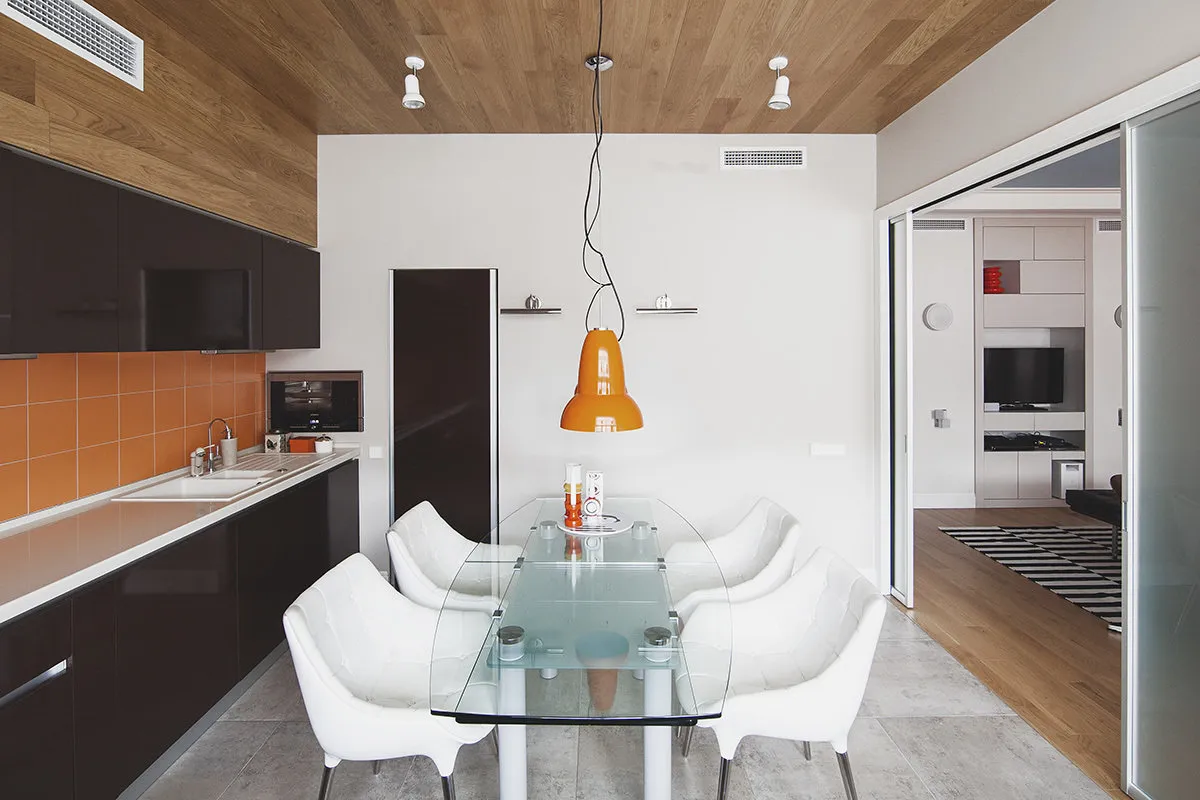
Design: Irina Krascheninnikova
Dark Floor Color
An elegant and noble shade suitable for any kitchen interior style. Dark flooring also has its "secrets". If it harmonizes well with a light ceiling and walls of the same color, the kitchen will visually expand. However, if the ceiling is dark, the kitchen will look low. Also, it should be mentioned that dark colors have many shades, and one of them will always suit the surrounding environment better.

Design: Art Spice studio, Jeni Yasnets, Svetlana Dyakova
Other Color Solutions
One option is a multi-colored floor. It looks not only original but also stylish. When combining shades, it is important to remember the main principle: a smooth transition from one color to another and their compatibility. If the kitchen is small, it is not recommended to make a multi-colored floor, as it will visually make the small room even smaller.
Besides light and dark tones, you can also use other colors. It is important to pay attention to the evenness of the kitchen floor. If there are defects on it in the form of depressions or bumps, it is better to avoid bright shades, as defects will become more noticeable. To mask them, you can use patterns.
When selecting material for kitchen flooring, it is important to consider many details: the strength of the material, its resistance to external impact, ease of installation and cleaning, color. All these factors, when properly combined, will help to achieve comfortable and durable coverage that will not burden the wallet too much and will delight the household members for a long time.

